On the way to a successful project: 11 tips for effective communication with the client and the team
Hello! I work as a project manager for about a year. Some projects developed successfully - the pitfalls did not sink the product, and now it lives and develops. Others were accompanied by unprofessional behavior and stupid mistakes.
However, I like my job, and I am not too lazy to delve into these errors in order to find their cause. And she, as a rule, is the following: someone did not understand something . The developer did not understand the task, the client did not understand the team, the manager did not understand the meaning of the project, and so on. Misunderstanding leads to a breakdown of deadlines and budgets, to the wrong expectations of the client, to the confusion of the end users and to the restless sleep of the manager.
The source of misunderstanding is the lack of effective communication. When it is not there, it is impossible to build an effective system for assigning and performing tasks. With my advice, I want to help you fix it.
')

Once in the company, the Living Typing held such an experiment: each manager drew an image with which he associated his profession. For me, an effective manager is Ganesh, the Hindu god of well-being and wisdom. His head is an elephant and a lot of hands - with a long trunk, the manager Ganesh takes risks, hears the team and the client with big ears, he resolves any situation with dozens of hands.

Divine enlightenment must necessarily find every manager. Without it, communication suffers, and as a result, the fulfillment of tasks suffers. In this article I will give some tips from my own experience, and I suggest you to share yours in the comments.
The first thing to do on the road to successful communication is learning to talk. Conversations are what the work of the manager consists of. Extraneous thoughts and internal dialogues will interfere with listening and hearing the interlocutor, confuse with the purpose of the conversation.
Sometimes being here and now takes effort. To return to the conversation entirely, you will be helped by a simple exercise, which psychologists recommend to people who are prone to experiencing stressful situations over and over again: as soon as you begin to lose the thought of the client and think about deadline tomorrow or forgotten iron - imagine a bright sign of STOP. And listen again. Regular practice of this technique leads to the prevention of their distractions and a quick return to the conversation.

If you are in a meeting, send everyone who “just ask” to the instant messenger - there their questions will not be forgotten and not lost, and you will answer them as soon as you finish. Let's be honest, not many “just ask” require a momentary decision. Managers often have this option - to react instantly, and this is great, but communication suffers from this kind of distractions.

Record conversations on a dictaphone or Monosnap, rehearse them, write abstracts, summarize and prepare questions for the next meeting. Align the theses and results with the interlocutor - so you are sure to say and think about the same thing. Part of the misunderstandings can be revealed already at this stage.
Sometimes misunderstandings arise after a considerable time after the conversation, and his record will help you understand. So one of my clients, a few days before the release, remembered that "he was still waiting for such an option, but we did not do it." In fact, even the discussion of this option was not, otherwise much of the project would have been done differently. I recorded all the negotiations, which allowed us to resolve this issue with literally one phrase: "Help me, please, remember when there could be such a conversation, and I will raise the records." The client did not find what to answer to it, and just switched to another topic.
Vlad Korobov, CEO Live Tipping :
“Each meeting should leave after itself the documentary evidence that it took place. Therefore, meetings should always be recorded - in the process (for example, using Monosnap ) or after. The simplest thing is to confirm the agreement in a letter, or even better, when tasks are created in the management system. We use Trello , YouTrack and Basecamp systems).
Preparing for a meeting more than once saved my and other people's reputations. I often hold meetings in English, in which case it is critically important to speak my pitches and cues in advance. This will give the client a feeling that you know the language confidently. ”
Even if the manager is proficient in impromptu, he will hold the whole meeting with a feeling of awkwardness if he does not prepare for it.
Anonymously:
“Once I was in charge of creating an application for a device that a client released. At some point, the client arrived at the office and began to show it, but I did not bother to study his work in advance, although it was only two weeks before the release. I have never been so ashamed before. ”
Ask questions, retell in your own words the thought of the interlocutor, again and again confirm that you mean the same thing. Phrases like "you want to say that ...", "Do I understand correctly that ..." and so on - your tools are chasing meanings.
Sometimes the client is the farthest from the state of divine enlightenment. He swears and nervous how much in vain. Or maybe the other way around is happy about your joint success. In such cases, you need to behave the opposite: to start a non-reflexive hearing. Say "I am also very happy" or "I am sorry that this happened," according to nod and hum. Be empathetic, be in the moment with the client, experience his emotion - it brings together.

A person is inclined to remember himself as good, and forgetting himself as bad. This remarkable property is necessary, probably, so that the weight of being is not so unbearable. By the same electoral principle, memory works in relation to agreements, conditions, obligations. As you can see, your head takes care of that it is easier for you to live, so fix everything important on paper, in gugldocs, task-managers, in audio and video.
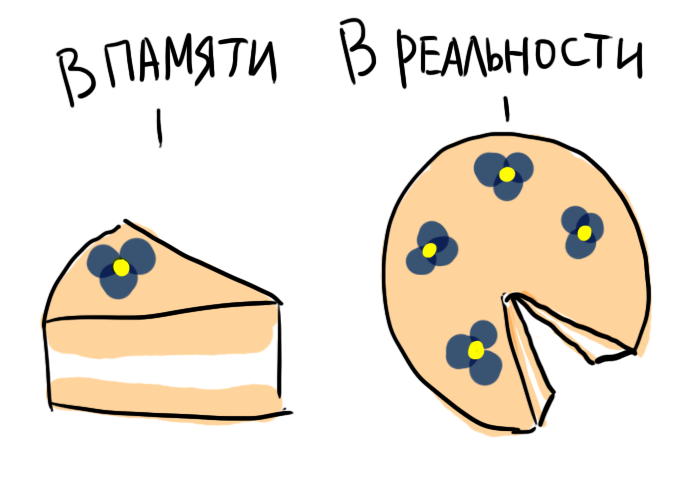
From the manager depends on the mood of the whole team. It sets the attitude to failures and successes, and the manager's behavior can interfere with the fragile crystallization process of the team. Share your bad mood with everyone; Remind casually that everything is vanity and decay, we will die, and our project even more so; give command roles to the school manners ("clever", "extreme", "best friend"), and any work becomes painful, because the atmosphere is poisoned. Of course, most of all the manager can not grumble at the client. He defends his interests in front of the team, and the team in front of the client. It is necessary to behave correctly in order not to rock the bridge of mutual understanding and joint movement towards the goal.
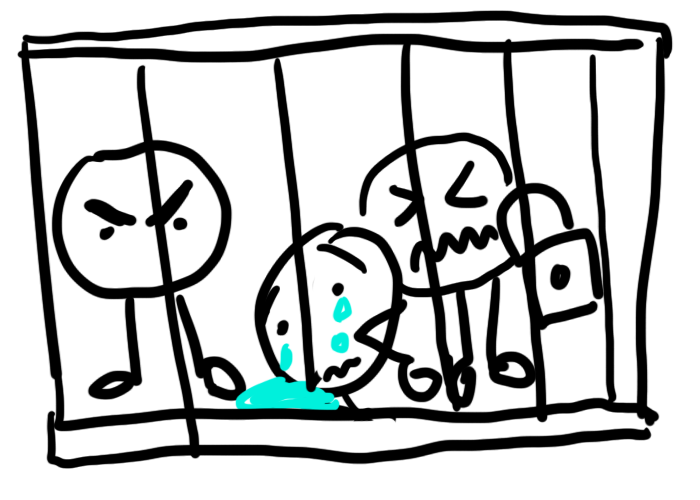
Be sure to tell each team member (even one who came for the sake of one small task) what the salt of the project is. The magnitude of the consequences of lack of information is impossible to predict: so my one project turned from a ten-hour project into a month and a half.
The situation was absurd: a freelancer worked with me in the same team, whose task was to replace the texts and pictures in the application. In a normal situation, the pictures were updated from the server, but during the work of the freelancer the client server was “lying”. The freelancer, having decided that this is the way it should, simply deleted the entire server part from the application, and “stitched” the content. At that time I had little experience, and there was no suspicion why he suddenly needed more time. And only when the client received the “Where is the“ Refresh ”button?” I figured out what the freelancer did and grabbed my head.

Suppose with the team peace, friendship, chewing gum. How to let a client into this world of harmony? First, the client, the manager, and the team must all speak the same language. Each concept of TK must be brought to a single understanding. Pulls call feature is not as you agreed? Or discuss it with everyone (maybe, really, everybody has long been pulling it to rename it), or give up on it and slow down - you don’t need to throw garbage in communication.
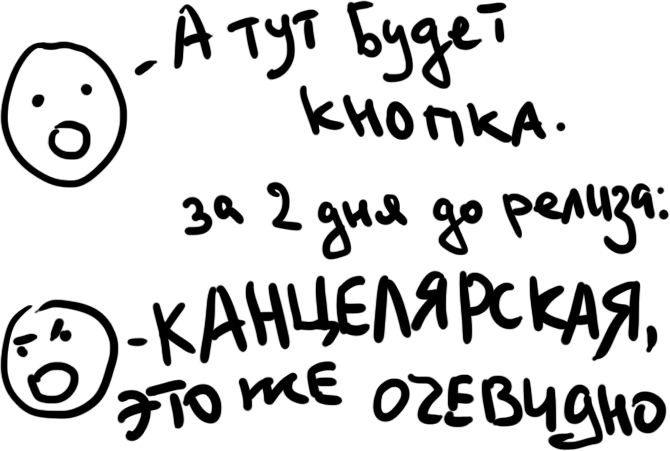
You are a specialist, but the customer has a vision of the product. The really cool managers find out not what the client wants (“I want everything to shine and blink”), but what they need (“It’s necessary not to be like everyone else, you need to be remembered”). Using reflexive listening, you can extract this information and change the project for the better. Most of the clients that the managers sent to hell simply were not listened to, and the managers did not care about their projects, or they didn’t feel the strength to change anything, but only to complain anonymously.
Daria Abramova, Live Tipping Manager:
“Recently, I have been asking the client why he needs this or that solution. I will give an example. While working on the school application, we were asked to implement the opportunity to comment on the posts from the teacher. The teacher needs to understand whether his message was read or not, and commenting was the only way for the client to show it. After discussing the details, we found out that making the status of a message would be more convenient, easier and cheaper. ”
The feeling that you are engaged in an unnecessary garbage - especially if it glitters and flashes, as in the example above - is terrible: it demotivates and poisons life every day. And a client, having released a product and not having received the expected result, can come to you with the question: “What went wrong?”. Or not to come, and this is even sadder. But a huge number of tasks can fall off as unnecessary when really important ones appear. Seeing in their favor, the team will catch fire.
Alexandra Abakumova, Live Taiping manager.
“One of our projects was closed three months after the release. Before the start of development, client analysts did not draw up a business plan to determine the target group, promotion and monetization. The customer was nurtured by the belief that the application - and this was a mobile application - would bring users together by the fact of its release, but the expectations were not met. “Help,” they asked us. But when it became clear to the project investor that there was no point in waiting for the invested funds back, he refused to support our client. ”

How to change the project for the better if the client brought a layout with a big red “Buy” button and he likes it so much? Changes can be pushed using PIN technology. This is an abbreviation composed of the words "positive", "interest" and "negative". In turn, disclose the attention of these three aspects:
“Positive” - what's successful is still in the idea of the client (“Red can be accentuated and added to some other elements”)
"Interest" - that from the proposed, you can beat the other way ("Animation can be done like this, and it will not be intrusive, but it will attract attention")
“Negative” - from what you absolutely refuse: “Here, for example, screenshots of top online stores. See, they do not have a big “Buy” button in the center of the page, because (a) ..., b) ..., c) ...). I do not advise doing so. ”
Draw mockups, collect screenshots, suggest options, fight. You always have time to do badly.

The task assigned to the developer and demonstrated to the client may look different. For example, inside a project I crush tasks, but I give the timing to the client, where one task is actually a pool of smaller ones. Basically, tasks are recorded in the team field, the result is tracked in the client field (although, of course, it works the other way around). This allows the team to be more flexible and shuffle tasks, and the client to see progress.
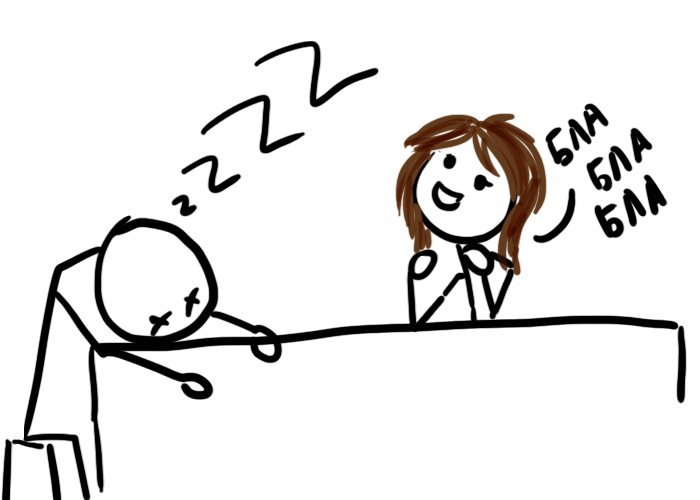
Include in the task description links to additional materials, quotes from customers or testers, deadlines, and expected results. Do a minimum of fog and a maximum of specificity.
With tasks on your project, everything will be ok if you:
These methods help me lead and complete projects with a minimum of headaches. I hope they will help you. If you have your own repeatedly proven approaches, I will be glad to see them in the comments.
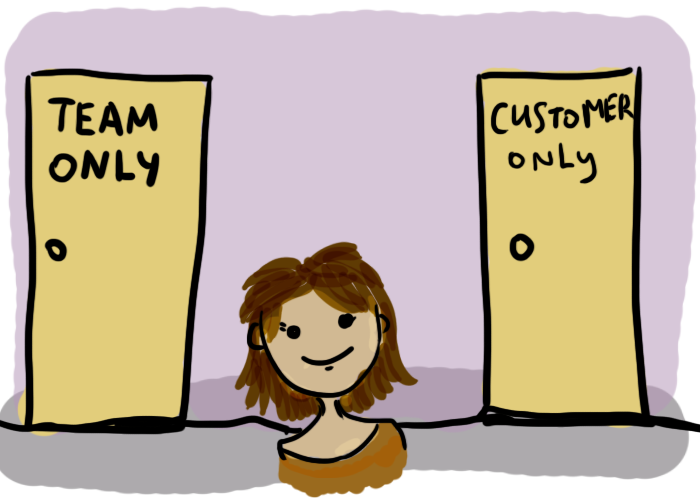
However, I like my job, and I am not too lazy to delve into these errors in order to find their cause. And she, as a rule, is the following: someone did not understand something . The developer did not understand the task, the client did not understand the team, the manager did not understand the meaning of the project, and so on. Misunderstanding leads to a breakdown of deadlines and budgets, to the wrong expectations of the client, to the confusion of the end users and to the restless sleep of the manager.
The source of misunderstanding is the lack of effective communication. When it is not there, it is impossible to build an effective system for assigning and performing tasks. With my advice, I want to help you fix it.
')

Once in the company, the Living Typing held such an experiment: each manager drew an image with which he associated his profession. For me, an effective manager is Ganesh, the Hindu god of well-being and wisdom. His head is an elephant and a lot of hands - with a long trunk, the manager Ganesh takes risks, hears the team and the client with big ears, he resolves any situation with dozens of hands.

Divine enlightenment must necessarily find every manager. Without it, communication suffers, and as a result, the fulfillment of tasks suffers. In this article I will give some tips from my own experience, and I suggest you to share yours in the comments.
Rule number one : be here now
The first thing to do on the road to successful communication is learning to talk. Conversations are what the work of the manager consists of. Extraneous thoughts and internal dialogues will interfere with listening and hearing the interlocutor, confuse with the purpose of the conversation.
Sometimes being here and now takes effort. To return to the conversation entirely, you will be helped by a simple exercise, which psychologists recommend to people who are prone to experiencing stressful situations over and over again: as soon as you begin to lose the thought of the client and think about deadline tomorrow or forgotten iron - imagine a bright sign of STOP. And listen again. Regular practice of this technique leads to the prevention of their distractions and a quick return to the conversation.

Rule number two: respect the time of your interlocutor
If you are in a meeting, send everyone who “just ask” to the instant messenger - there their questions will not be forgotten and not lost, and you will answer them as soon as you finish. Let's be honest, not many “just ask” require a momentary decision. Managers often have this option - to react instantly, and this is great, but communication suffers from this kind of distractions.

Rule number three: get ready for meetings
Record conversations on a dictaphone or Monosnap, rehearse them, write abstracts, summarize and prepare questions for the next meeting. Align the theses and results with the interlocutor - so you are sure to say and think about the same thing. Part of the misunderstandings can be revealed already at this stage.
Sometimes misunderstandings arise after a considerable time after the conversation, and his record will help you understand. So one of my clients, a few days before the release, remembered that "he was still waiting for such an option, but we did not do it." In fact, even the discussion of this option was not, otherwise much of the project would have been done differently. I recorded all the negotiations, which allowed us to resolve this issue with literally one phrase: "Help me, please, remember when there could be such a conversation, and I will raise the records." The client did not find what to answer to it, and just switched to another topic.
Vlad Korobov, CEO Live Tipping :
“Each meeting should leave after itself the documentary evidence that it took place. Therefore, meetings should always be recorded - in the process (for example, using Monosnap ) or after. The simplest thing is to confirm the agreement in a letter, or even better, when tasks are created in the management system. We use Trello , YouTrack and Basecamp systems).
Preparing for a meeting more than once saved my and other people's reputations. I often hold meetings in English, in which case it is critically important to speak my pitches and cues in advance. This will give the client a feeling that you know the language confidently. ”
Even if the manager is proficient in impromptu, he will hold the whole meeting with a feeling of awkwardness if he does not prepare for it.
Anonymously:
“Once I was in charge of creating an application for a device that a client released. At some point, the client arrived at the office and began to show it, but I did not bother to study his work in advance, although it was only two weeks before the release. I have never been so ashamed before. ”
Rule number four: master the reflexive listening
Ask questions, retell in your own words the thought of the interlocutor, again and again confirm that you mean the same thing. Phrases like "you want to say that ...", "Do I understand correctly that ..." and so on - your tools are chasing meanings.
Sometimes the client is the farthest from the state of divine enlightenment. He swears and nervous how much in vain. Or maybe the other way around is happy about your joint success. In such cases, you need to behave the opposite: to start a non-reflexive hearing. Say "I am also very happy" or "I am sorry that this happened," according to nod and hum. Be empathetic, be in the moment with the client, experience his emotion - it brings together.

Rule number five: do not trust the important information of your memory.
A person is inclined to remember himself as good, and forgetting himself as bad. This remarkable property is necessary, probably, so that the weight of being is not so unbearable. By the same electoral principle, memory works in relation to agreements, conditions, obligations. As you can see, your head takes care of that it is easier for you to live, so fix everything important on paper, in gugldocs, task-managers, in audio and video.

Rule number six: toxic emotions are not needed.
From the manager depends on the mood of the whole team. It sets the attitude to failures and successes, and the manager's behavior can interfere with the fragile crystallization process of the team. Share your bad mood with everyone; Remind casually that everything is vanity and decay, we will die, and our project even more so; give command roles to the school manners ("clever", "extreme", "best friend"), and any work becomes painful, because the atmosphere is poisoned. Of course, most of all the manager can not grumble at the client. He defends his interests in front of the team, and the team in front of the client. It is necessary to behave correctly in order not to rock the bridge of mutual understanding and joint movement towards the goal.

Rule number seven: maximize team involvement
Be sure to tell each team member (even one who came for the sake of one small task) what the salt of the project is. The magnitude of the consequences of lack of information is impossible to predict: so my one project turned from a ten-hour project into a month and a half.
The situation was absurd: a freelancer worked with me in the same team, whose task was to replace the texts and pictures in the application. In a normal situation, the pictures were updated from the server, but during the work of the freelancer the client server was “lying”. The freelancer, having decided that this is the way it should, simply deleted the entire server part from the application, and “stitched” the content. At that time I had little experience, and there was no suspicion why he suddenly needed more time. And only when the client received the “Where is the“ Refresh ”button?” I figured out what the freelancer did and grabbed my head.

Rule number eight: one language at all
Suppose with the team peace, friendship, chewing gum. How to let a client into this world of harmony? First, the client, the manager, and the team must all speak the same language. Each concept of TK must be brought to a single understanding. Pulls call feature is not as you agreed? Or discuss it with everyone (maybe, really, everybody has long been pulling it to rename it), or give up on it and slow down - you don’t need to throw garbage in communication.

Rule number nine: do not think out even the most obvious things for a customer
You are a specialist, but the customer has a vision of the product. The really cool managers find out not what the client wants (“I want everything to shine and blink”), but what they need (“It’s necessary not to be like everyone else, you need to be remembered”). Using reflexive listening, you can extract this information and change the project for the better. Most of the clients that the managers sent to hell simply were not listened to, and the managers did not care about their projects, or they didn’t feel the strength to change anything, but only to complain anonymously.
Daria Abramova, Live Tipping Manager:
“Recently, I have been asking the client why he needs this or that solution. I will give an example. While working on the school application, we were asked to implement the opportunity to comment on the posts from the teacher. The teacher needs to understand whether his message was read or not, and commenting was the only way for the client to show it. After discussing the details, we found out that making the status of a message would be more convenient, easier and cheaper. ”
Rule number ten: consider the benefits of the project with the client
The feeling that you are engaged in an unnecessary garbage - especially if it glitters and flashes, as in the example above - is terrible: it demotivates and poisons life every day. And a client, having released a product and not having received the expected result, can come to you with the question: “What went wrong?”. Or not to come, and this is even sadder. But a huge number of tasks can fall off as unnecessary when really important ones appear. Seeing in their favor, the team will catch fire.
Alexandra Abakumova, Live Taiping manager.
“One of our projects was closed three months after the release. Before the start of development, client analysts did not draw up a business plan to determine the target group, promotion and monetization. The customer was nurtured by the belief that the application - and this was a mobile application - would bring users together by the fact of its release, but the expectations were not met. “Help,” they asked us. But when it became clear to the project investor that there was no point in waiting for the invested funds back, he refused to support our client. ”

How to change the project for the better if the client brought a layout with a big red “Buy” button and he likes it so much? Changes can be pushed using PIN technology. This is an abbreviation composed of the words "positive", "interest" and "negative". In turn, disclose the attention of these three aspects:
“Positive” - what's successful is still in the idea of the client (“Red can be accentuated and added to some other elements”)
"Interest" - that from the proposed, you can beat the other way ("Animation can be done like this, and it will not be intrusive, but it will attract attention")
“Negative” - from what you absolutely refuse: “Here, for example, screenshots of top online stores. See, they do not have a big “Buy” button in the center of the page, because (a) ..., b) ..., c) ...). I do not advise doing so. ”
Draw mockups, collect screenshots, suggest options, fight. You always have time to do badly.

Rule number eleven: the task should be specific, meaningful and descriptive at the same time for both the developer and the client.
The task assigned to the developer and demonstrated to the client may look different. For example, inside a project I crush tasks, but I give the timing to the client, where one task is actually a pool of smaller ones. Basically, tasks are recorded in the team field, the result is tracked in the client field (although, of course, it works the other way around). This allows the team to be more flexible and shuffle tasks, and the client to see progress.

Include in the task description links to additional materials, quotes from customers or testers, deadlines, and expected results. Do a minimum of fog and a maximum of specificity.
Let's sum up
With tasks on your project, everything will be ok if you:
- open to dialogue within the team and in communication with the client, carefully hold and document the meetings
- within the team and in communicating with the client, you name things the same way;
- do not think out the meaning and goals of the client;
- collect all the information on the task in clear and consistent wording;
- have two task tracking fields: internal command and external for client.
These methods help me lead and complete projects with a minimum of headaches. I hope they will help you. If you have your own repeatedly proven approaches, I will be glad to see them in the comments.

Source: https://habr.com/ru/post/313576/
All Articles